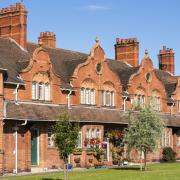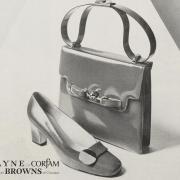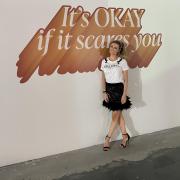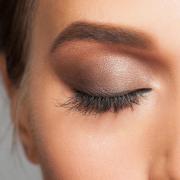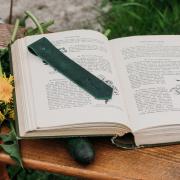The Arley estate has been in the hands of the Warburton family since the end of the 12th century, with the first grand house built on the land in 1469, by Piers Warburton.
The first Arley Hall was a typical medieval timber-framed building, surrounded by a square moat. In the late 16th century, a three-storey south front was added, making the house a complete square with a large internal courtyard. By the mid-18th century, the structure of the house was deteriorating, so in 1758, Sir Peter Warburton, 4th Baronet, encased the building in new brick walls.
Rowland Egerton-Warburton
In 1813, the hall and estate were inherited by eight-year-old Rowland Egerton-Warburton. As soon as he came of age, in 1826, the young landowner decided to replace the house in its entirety. His desire was that it should reflect the antiquity of his inheritance but should have all the modern comforts available to a wealthy gentleman of the 19th century. He chose Nantwich-based George Latham as his architect, who submitted plans for an Elizabethan-style manor house, where every feature would have an exact model in an existing Elizabethan building. Egerton-Warburton and Latham visited 16th-century houses across the country to achieve this aim, and this is the house you can visit today.

'Rowland has a passion for Elizabethan and Jacobean houses and wanted his new build home to reflect his family’s longstanding, without compromising on everything a wealthy family of that era could expect to enjoy,' Bridget Roberts, general manager of Arley Hall and Gardens, explains.
The Library
'The library, which was used as Tommy Shelby’s office in the Peaky Blinders series, is original to Rowland’s build. The frieze, with the birds and the foxes, and the panelling and bookcases were designed for him. He was very learned, and collected an amazing number of books, and the earliest ones here date from the late 1700s.
Alphabet
He put the alphabet around the top of the bookshelves and filed his books by the author’s surname, and what is lovely to see is how the different letters are given different spaces – so D is huge, for example, and W is very tiny. There are about 2,500 books here and every generation has added to the collection.”

The stained-glass windows also seem to date from a much earlier age but were brought to Arley from Paris in the 1840s, and depict the process of getting older, from exuberant youth to tired old age.
‘One of the things we love about the hall is that it is still very homely, even though Lord and Lady Ashbrook no longer live here. It’s not a museum that has been caught in a certain period, every generation has added to it since it was built.'
The dark blue walls make the golden tones of the woodwork glow, while the Elizabethan-style plastered ceiling adds height and light.

'The production team for Peaky Blinders did a lot of research around what colour scheme would have been used around the time the series was set and chose this dark blue. Obviously, when they finished filming they put everything back to precisely how it was, but we asked them not to re-paint, as we believe this colour scheme is how it would have been in Rowland’s time, not the more pastel shades the first Lady Ashbrook chose when she redecorated the hall in the 1950s.'
From one amazing space to another – the gallery. It was here that Rowland Egerton would entertain family and friends. Having arrived in the very grand front hall, filled with portraits of Warburtons dating back to the 16th century, guests would move to the gallery, another grand wood-panelled space, with magnificent ceilings and ancient artwork, set up in grand Victorian style with furniture and aspidistra abounding.

It was the current Lord Ashbrook’s mother, Elizabeth Egerton-Warburton, who brought the title to Arley, when in 1936 she married Desmond Llowarch Edward Flower, of the Flower family, Anglo-Irish nobility whose title dates back to 1751, and it is in the Gallery you will find the family portraits of the Flower family, and can track their progress from baron to viscount, while admiring the fashions of the ages.
The panelling, originally dark oak, is now a golden toasted honey, changed by Lady Elizabeth as part of her desire to refresh the hall after the end of World War II.
'Lady Elizabeth had all the walls painted in soft, pastel shades, and the ceilings too, which were originally all white. She used ammonia to strip back the wood panelling to lighten it all up’ Karen McGuinness, tour guide at Arley Hall says: ‘She was quite the action lady and a lot of what you see here in the house and the gardens is attributable to her.

'During these renovations, Lady Elizabeth made a romantic discovery. Rowland married Mary Brooke, of Norton Priory, and enjoyed a very happy marriage for 50 years. For this anniversary he bought her a beautiful gold bracelet, but sadly she died just two weeks later. The bracelet was put away, into the panelling of the gallery, where it remained for more than 100 years, before being rediscovered by Lady Elizabeth.’
Bridget adds: 'This is the main room used for wedding breakfasts and was the main room used for Thomas Shelby’s wedding reception in Peaky Blinders. It’s also used a lot in the current filming for a Netflix series, but you wouldn’t recognise it, as they built a fake fireplace to hide this one.'
Interestingly, the fireplace isn’t original to Rowland Warburton’s building. It was discovered by Lady Elizabeth at an estate sale and brought here. One wonders what glorious home lost this piece, and has since been lost to time.

'The drawing room at Arley Hall is now used for weddings and was from the start perhaps the most elegant and feminine room in the hall,’ Bridget says.
The room was very much designed to impress visitors to the home, with its elegant and intricately plastered ceiling, the frieze with its gold leaf, the crystal chandelier and the portrait of Rowland over the fireplace demonstrating wealth, taste and a long heritage.
The drawing room leads to the staircase hall, a glorious full height space, capped with a domed ceiling lantern, allowing natural light to pour down through the cantilevered staircase and showcase the art.
'In Rowland’s day this would have been lit by candles, and then gaslight, so he put the lantern in to cascade all the light through,' Karen says. “The cantilevered staircase is very unusual, and an amazing piece of engineering. It’s in Elizabethan style, so he must have seen it somewhere on his travels and thought, oh, I’ll have one of those.’

'This is an area that’s also been repainted by Peaky Blinders,’ Bridget says. ‘When they came in they took all the paintings down and replaced them with portraits of the Shelbys, covered one painting that doesn’t come off the wall with a tapestry, and painted it all this dark grey. It was a pale lemon colour previously, chosen by Lady Elizabeth and when they came to put it back how it was, they asked what colour we’d like. This really shows off all the wood and the artwork, so we asked them to leave it how it is, which I think they were quite relieved about.’
Arley Hall is privately owned, so must raise all funds needed for its upkeep itself. As well as weddings, festivals in the grounds and events such as the Harry Potter Forbidden Forest Experience and Antiques Roadshow, the estate hosts film crews regularly. In addition to the Peaky Blinders series, where hall acted as Thomas Shelby’s ‘look how well I’ve done’ home, Arley has hosted film crews from Coronation Street, Hollyoaks, Brassic, Mr Tumble, The Forsyte Saga, a Bollywood horror movie and The Voice. Luminaries from stage and screen have walked its floors – perhaps not so grand as Charles-Louis Napoléon Bonaparte who stayed at Arley Hall in 1847-48 (for the hunting season, of course), but Joanna Lumley, Cillian Murphy and Damian Lewis probably tick a few more popular culture boxes than the self-proclaimed Emperor of France, Napoléon III.
'Arley is very popular as a filming location,’ Bridget says. ‘As we are privately owned, there’s a lot here we can agree to that National Trust properties just cannot. We let them decorate, we move furniture, we take paintings down, and as long as the family are happy to do it, we can do it.’
arleyhallandgardens.com
The photography for this feature was kindly supplied by Christopher John, a professional photographer specialising in landscapes, architecture and interiors.
christopherjohnphotography.co.uk











